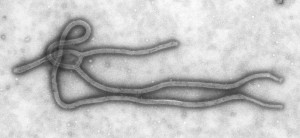 Hosts: Vincent Racaniello, Alan Dove, Rich Condit, and Kathy Spindler
Hosts: Vincent Racaniello, Alan Dove, Rich Condit, and Kathy Spindler
The TWiVites present an all-ebolavirus episode, tackling virology, epidemiology, and approaches to prevention and cure that are in the pipeline.
Click arrow to play
Download TWiV 297 (83 MB .mp3, 115 min)
Subscribe (free): iTunes, RSS, email
Links for this episode
- Risks and benefits of gain-of-function experiments (mBio)
- Scientists for Science
- US Policy for oversight of DURC (pdf)
- US framework for guiding H5N1 transmission expts (pdf)
- Extra oversight for H7N9 experiments (Science)
- TWiV 283: No Reston for the weary
- Is it Ebolavirus or Ebola virus? (virology blog)
- Ebola virus disease update (WHO)
- Ebola virus disease FAQ (WHO)
- Ebola hemorrhagic fever (CDC)
- Ebola virus disease: ecology meets economy (PLoS NTD)
- 2014 Ebola virus outbreak (J Gen Virol)
- 2014 Ebola virus outbreak (MMWR)
- If Ebola virus came to the US (Vox)
- Zaire ebolavirus in West Africa (interview with Tom Solomon)
- Why Ebola patients were brought to US (Wash Post)
- Experimental treatment and vaccines for Ebola (CDC)
- Aerosol transmission of Reston virus (Sci Rep)
- Ebola – A growing threat? (NEJM)
- On the cusp of Ebola vaccine (Know)
- Ebolavirus vaccines and antivirals (virology blog)
- Immune responses to Ebolavirus infection (Exp Rev Clin Imm)
- Antibody therapy for Ebola (Hum Vacc Immunother)
- Plant derived monoclonals protect macaques from Ebolavirus (PNAS)
- Anti-ebolavirus monoclonal cocktail (Sci Trans Med)
- ZMapp info sheet (pdf)
- ZMapp PR (pdf)
- High tech treatment for Ebola (ArsTechnica)
- ZMapp protects macaques (Sci Rep)
- Letters read on TWiV 297
Weekly Science Picks
Alan – Historical perspective on Ebola (Tara C Smith)
Rich – Tell the negative committee to shut up (Fanuel Muindi)
Kathy – Art of Night (Vimeo)
Vincent – Is Ebola virus going to kill me? (John Skylar)
Listener Pick of the Week
Peter – Dr. Michael Saag interview by Dr. Virginia Campbell
David – PI Predictor (app, article, publication)
Send your virology questions and comments (email or mp3 file) to [email protected]


Reflecting on this episode, I regret not having included more about the function of individual Ebolavirus gene products in the introduction to these viruses, so this comment is an attempt to correct that omission. Follow along using the diagram of Ebolavirus on ViralZone: http://viralzone.expasy.org/viralzone/all_by_species/207.html
The G protein is the major external viral structural glycoprotein. (Kathy nicely describes glycoproteins later in the episode.) The filamentous virus particle that everyone is now probably familiar with (see episode image) is surrounded by a lipid membrane that is derived by virus budding through the cell membrane during virus assembly, and the G protein is anchored to and protrudes from the viral membrane thus coating the outer surface of the virus. G protein is responsible for attachment and uptake of the virus into cells so it is critical for the initial stages of infection. It is also the major protein that the immune system “sees” on the virus particle during infection. Antibodies neutralize the virus by binding to this protein, and the different serotypes of virus have subtle differences in the structure of this protein so that most antibodies that react with the G protein from one species of Ebolavirus do not react well with another species of Ebolavirus. It is for these reasons that so much attention is focused on the G protein, in particular in the construction of vaccines and therapeutics.
The nucleoprotein coats the RNA genome that resides within the virion membrane. I think it is reasonable to think of the RNA-nucleoprotein particle as a sort of virus chromosome within the particle. The nucleoprotein protects the RNA and also participates in transcription of the RNA into either mRNA or genomic RNA.
The matrix protein lies between the RNA-nucleoprotein particle and the membrane and contacts both; it is a key structural component of the virus.
The polymerase (called “L” for “large”) is responsible for copying the RNA genome into either mRNA, anti-genomic RNA, or ultimately more genomic RNA (see TWiV 60, “Making Viral RNA” (http://www.twiv.tv/2009/11/29/twiv-60-making-viral-rna/). It actually has two subunits; the other is VP35. Because cells don’t normally copy RNA into RNA, the viral polymerase is different than cellular polymerases and therefore potentially makes a good “druggable” target, as discussed later in the episode.
Thanks for sharing my article, TWiV docs! I really like the rest of the episode, too–I’m sharing it with my own fanbase.
I have shared this episode with friends and family in the hopes they will listen and any unwarranted fears will be assuaged. It was a long TWiV, however, it was one of the most interesting TWiVs ever. I worked in a county public health department in the communicable disease clinic and in epidemiology as a nurse. One of the key functions in public health is to do outreach and provide conduits to help inform our community about diseases, related risks and preventive measures. You provide ammunition for some of us who (although retired) continue to refer the public to the best resources. Thank you all for your expert efforts.
Thanks for sharing your timely thoughts on this issue! I’m curious, though: why the dismissal of Richard Preston’s “The Hot Zone”? Does every science writer have to be a scientist? Isn’t it enough to have qualified sources and fact-checking? Yes, the book was luridly written and portrayed certain personalities in a less-than-flattering light, but I couldn’t find much mendacity in what he presented. If you could share any mistakes that stood out for you, it’d be appreciated, as this book still pulls a lot of social weight; not only because it was a best-seller 20 years ago — it’s required reading for countless secondary school curricula.
Dr. Racaniello, can you please post a link for the scientist for science organization? Thank you!
Never mind! I just missed it above.